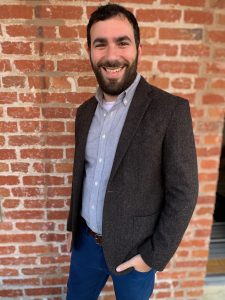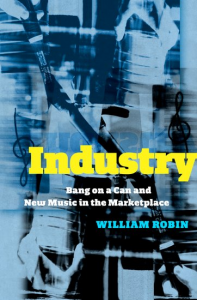
This new weekly series, Book Notes, will feature recently released books by a handful of our musicology graduate alumni each Thursday in May. This week, we’re featuring Dr. William Robin and his recent book, Industry: Bang on a Can and New Music in the Marketplace, published by Oxford University Press in February (2021).
William Robin, Ph.D. 2016, is an assistant professor of musicology at the University of Maryland’s School of Music. His research explores how institutions structure the creation, dissemination, and reception of contemporary classical music in the United States. Recent publications, aside from his new book, include an exploration of the term “indie classical” in the Journal of the Society for American Music, an article on new music and neoliberalism in the Journal of the American Musicological Society, and an examination of patronage and politics at the New York Philharmonic’s 1983 Horizons festival in Musical Quarterly. As a public musicologist, Robin contributes to The New York Times, hosts the podcast Sound Expertise, and tweets as @seatedovation.
Can you give us a short synopsis of your book?
Dr. Robin: Industry is an intellectual and institutional history of contemporary classical music in the United States in the late twentieth century, through the lens of the organization Bang on a Can. Beginning in the late 1980s, Bang on a Can began presenting eclectic marathons of avant-garde music in downtown New York, and quickly expanded into a multi-faceted organization with enormous reach and a large audience; my book explores this expansion amidst a larger “marketplace turn” in American contemporary music, in which upstart and established institutions alike sought to find a new audience for new music.
How does Bang on a Can fit into your research interests?
Dr. Robin: Going back to my studies at Chapel Hill and the courses I took there, I’ve been interested in the intersections between classical and popular music; how institutions structure musical life; and how neoliberal capitalism and funding relate to contemporary music. Bang on a Can, along with being an important institution in new music today, allowed for an exploration of all these issues.
 What inspired you to write this book in particular?
What inspired you to write this book in particular?
Dr. Robin: I had written a dissertation partly on Bang on a Can, but more focused on the post-2000 scene; I wanted to back up to the 1980s and 1990s for my book to better understand a period that is crucial to new music today but not understood by many composers who didn’t live through it — and people who didn’t live through it, like me.
Were there any surprises along the journey of writing this book?
Dr. Robin: Lots of surprises! Each facet of my research brought new twists and turns, as I discovered new people to talk to and new archives to check out. Some of the most rewarding moments were when I found archival stuff and brought it back to the people who created it: for example, I found a draft program of the very first Bang on a Can marathon from the late ’80s in an archive, which I then scanned and showed to the three Bang on a Can founders, who hadn’t seen it since 1987. It led to a lot of productive and fascinating conversations!
If readers could take away one thing from this book, what do you hope it would be?
Dr. Robin: I hope they understand that contemporary music is something that is deeply tied to how musical institutions function, from entrepreneurial startups all the way up to major government bureaucracies like the National Endowment for the Arts; I also make a strong case, towards the end of the book, for why public funding is necessary for the flourishing of avant-garde music in the United States today, something that is even more necessary in the wake of the pandemic.
